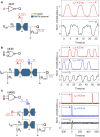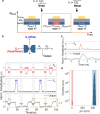Attojoule Superconducting Thermal Logic and Memories
- PMID: 40059548
- PMCID: PMC11926957
- DOI: 10.1021/acs.nanolett.4c06545
Attojoule Superconducting Thermal Logic and Memories
Abstract
Due to stringent thermal budgets in cryogenic technologies such as superconducting quantum computers and sensors, electronic building blocks that simultaneously offer low energy consumption, fast switching, low error rates, a small footprint, and simple fabrication are pivotal for large-scale devices. Here, we demonstrate a superconducting switch with attojoule switching energy, high speed (pico-second rise/fall times), and high integration density (on the order of 10-2 μm2 per switch). It consists of a superconducting nanochannel and a metal heater separated by an insulating silica layer. We experimentally demonstrate digital gate operations utilizing these nanostructures, such as NOT, NAND, NOR, AND, and OR gates, with a few femtojoules of energy consumption and ultralow bit error rates <10-8. In addition, we build energy-efficient volatile memory elements with nanosecond operation speeds and a retention time over 105 s. These superconducting switches open new possibilities for increasing the size and complexity of modern cryogenic technologies.
Keywords: Superconducting device; digital circuits; logic gate; memory device.
Conflict of interest statement
The authors declare no competing financial interest.
Figures





References
-
- Berggren K. Quantum Computing with Superconductors. Proceedings of the IEEE 2004, 92, 1630–1638. 10.1109/JPROC.2004.833672. - DOI
-
- Sobolewski R.; Verevkin A.; Gol’tsman G. N.; Lipatov A.; Wilsher K. Ultrafast superconducting single-photon optical detectors and their applications. IEEE Transactions on Applied Superconductivity 2003, 13, 1151–1157. 10.1109/TASC.2003.814178. - DOI
-
- Khan S.; et al. Superconducting optoelectronic single-photon synapses. Nature electronics 2022, 5, 650–659. 10.1038/s41928-022-00840-9. - DOI
LinkOut - more resources
Full Text Sources

